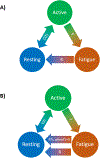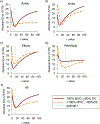Modification of a three-compartment muscle fatigue model to predict peak torque decline during intermittent tasks
- PMID: 29960732
- PMCID: PMC6092960
- DOI: 10.1016/j.jbiomech.2018.06.005
Modification of a three-compartment muscle fatigue model to predict peak torque decline during intermittent tasks
Abstract
This study aimed to test whether adding a rest recovery parameter, r, to the analytical three-compartment controller (3CC) fatigue model (Xia and Frey Law, 2008) will improve fatigue estimates during intermittent contractions. The 3CC muscle fatigue model uses differential equations to predict the flow of muscle between three muscle states: Resting (MR), Active (MA), and Fatigued (MF). This model uses a feedback controller to match the active state to target loads and two joint-specific parameters: F, fatigue rate controlling flow from active to fatigued compartments) and R, the recovery rate controlling flow from the fatigued to the resting compartments. This model does well to predict intensity-endurance time curves for sustained isometric tasks. However, previous studies find when rest intervals are present that the model over predicts fatigue. Intermittent rest periods would allow for the occurrence of subsequent reactive vasodilation and post-contraction hyperemia. We hypothesize a modified 3CC-r fatigue model will improve predictions of force decay during intermittent contractions with the addition of a rest recovery parameter, r, to augment recovery during rest intervals, representing muscle re-perfusion. A meta-analysis compiling intermittent fatigue data from 63 publications reporting decline in peak torque (% torque decline) were used for comparison. The original model over-predicted fatigue development from 19 to 29% torque decline; the addition of a rest multiplier significantly improved fatigue estimates to 6-10% torque decline. We conclude the addition of a rest multiplier to the three-compartment controller fatigue model provides a physiologically consistent modification for tasks involving rest intervals, resulting in improved estimates of muscle fatigue.
Keywords: Ergonomics; Isometric contraction; Mathematical modeling; Meta-analysis; Muscle fatigue.
Copyright © 2018 Elsevier Ltd. All rights reserved.
Conflict of interest statement
Conflict of Interest Statement:
None of the authors have any financial or personal conflicts of interest to report. The authors were funded in part by the United States Council for Automotive Research (USCAR), the National Institutes for Health, K01AR056134, and the University of Iowa Heartland Center (graduate student stipend).
Figures





Similar articles
-
Adapting a fatigue model for shoulder flexion fatigue: Enhancing recovery rate during intermittent rest intervals.J Biomech. 2020 Jun 9;106:109762. doi: 10.1016/j.jbiomech.2020.109762. Epub 2020 Apr 28. J Biomech. 2020. PMID: 32517992 Free PMC article.
-
Functional muscle group- and sex-specific parameters for a three-compartment controller muscle fatigue model applied to isometric contractions.J Biomech. 2021 Oct 11;127:110695. doi: 10.1016/j.jbiomech.2021.110695. Epub 2021 Aug 18. J Biomech. 2021. PMID: 34454329
-
Sensitivity analysis of sex- and functional muscle group-specific parameters for a three-compartment-controller model of muscle fatigue.J Biomech. 2022 Aug;141:111224. doi: 10.1016/j.jbiomech.2022.111224. Epub 2022 Jul 18. J Biomech. 2022. PMID: 35921702
-
A three-compartment muscle fatigue model accurately predicts joint-specific maximum endurance times for sustained isometric tasks.J Biomech. 2012 Jun 26;45(10):1803-8. doi: 10.1016/j.jbiomech.2012.04.018. Epub 2012 May 9. J Biomech. 2012. PMID: 22579269 Free PMC article.
-
Age-related differences in muscle fatigue vary by contraction type: a meta-analysis.Phys Ther. 2011 Aug;91(8):1153-65. doi: 10.2522/ptj.20100333. Epub 2011 May 26. Phys Ther. 2011. PMID: 21616932 Free PMC article.
Cited by
-
Effects of Vertical Lifting Distance on Upper-Body Muscle Fatigue.Int J Environ Res Public Health. 2021 May 20;18(10):5468. doi: 10.3390/ijerph18105468. Int J Environ Res Public Health. 2021. PMID: 34065333 Free PMC article.
-
Four-compartment muscle fatigue model to predict metabolic inhibition and long-lasting nonmetabolic components.Front Physiol. 2024 Mar 11;15:1366172. doi: 10.3389/fphys.2024.1366172. eCollection 2024. Front Physiol. 2024. PMID: 38550257 Free PMC article.
-
On the management of maternal pushing during the second stage of labor: a biomechanical study considering passive tissue fatigue damage accumulation.Am J Obstet Gynecol. 2022 Aug;227(2):267.e1-267.e20. doi: 10.1016/j.ajog.2022.01.023. Epub 2022 Jan 31. Am J Obstet Gynecol. 2022. PMID: 35101408 Free PMC article.
-
Adapting a fatigue model for shoulder flexion fatigue: Enhancing recovery rate during intermittent rest intervals.J Biomech. 2020 Jun 9;106:109762. doi: 10.1016/j.jbiomech.2020.109762. Epub 2020 Apr 28. J Biomech. 2020. PMID: 32517992 Free PMC article.
-
Applying a muscle fatigue model when optimizing load-sharing between muscles for short-duration high-intensity exercise: A preliminary study.Front Physiol. 2023 Apr 24;14:1167748. doi: 10.3389/fphys.2023.1167748. eCollection 2023. Front Physiol. 2023. PMID: 37168228 Free PMC article.
References
-
- Abdel-Malek K, Arora J, Yang JZ, Marler T, Beck S, Swan C, Frey-Law L, Kim J, Bhatt R, Mathai A, Murphy C, Rahmatalla S, Patrick A Obusek J, 2009. A physics-based digital human model. International Journal of Vehicle Design 51, 324–340.
-
- Allman BL Rice CL, 2003. Perceived exertion is elevated in old age during an isometric fatigue task. European Journal of Applied Physiology 89, 191–197. - PubMed
-
- Alway SE, Hughson RL, Green HJ, Patla AE Frank JS, 1987. Twitch Potentiation after Fatiguing Exercise in Man. European Journal of Applied Physiology and Occupational Physiology 56, 461–466. - PubMed
-
- Armatas V, Bassa E, Patikas D, Kitsas I, Zangelidis G Kotzamanidis C, 2010. Neuromuscular Differences Between Men and Prepubescent Boys During a Peak Isometric Knee Extension Intermittent Fatigue Test. Pediatric Exercise Science 22, 205–217. - PubMed
-
- Baker-Fulco CJ, Fulco CS, Kellogg MD, Glickman E Young AJ, 2006. Voluntary muscle function after creatine supplementation in acute hypobaric hypoxia. Medicine and Science in Sports and Exercise 38, 1418–1424. - PubMed
Publication types
MeSH terms
Grants and funding
LinkOut - more resources
Full Text Sources
Other Literature Sources

